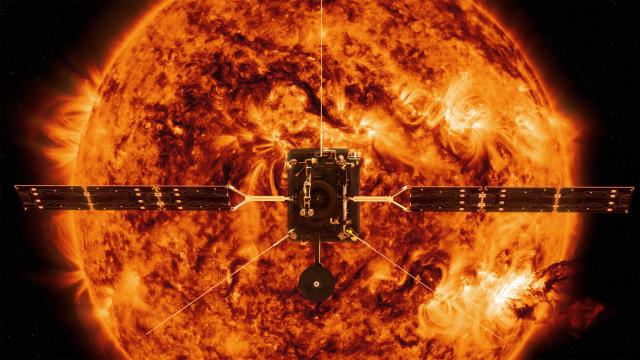Few 1-year-olds are as intrepid explorers as NASA and the European Space Agency’s Solar Orbiter. The space probe is already 222 million kilometres from Earth and is about to take baby’s first trip behind the Sun.
Launched on February 10, 2020, it’s finally conjunction season for the plucky little spacecraft, referring to the apparent proximity of the probe to the Sun when viewed by eyes on Earth. Built like a cosmic water skipper and charged with observing the Sun in unbelievable detail, Solar Orbiter will inspect everything from our star’s solar wind to its solar cycles. Now about 25,000 Great Walls of China away from Earth, the probe will be able to report back on never-before-seen features of the star.
“On 10 [February], we will be at perihelion; that is, the closest approach to the Sun of the current orbit, just under half the distance between the Sun and Earth,” said Daniel Müller, a Solar Orbiter project scientist with the ESA, in an email. “This will allow us to observe the Sun in very high resolution.”
Solar Orbiter is outfitted with several different imagers, which will peer at the Sun from a record proximity. (The cameras are already paying dividends, recently capturing three of the solar system’s planets in one field of view). There are numerous instruments looking at our Sun at any given time, but Solar Orbiter’s unique suite of instruments are offering a whole new perspective.
The orbiter doesn’t stand any immediate dangers from the heat on the far side of the Sun. It features a heat shield coated with black calcium phosphate, which helps the stargazer withstand temperatures of nearly 540 degrees Celsius.

Of greater concern is the capricious nature of the Sun’s heliosphere, which can disrupt radio signals from Earth that are trying to reach the probe, slowing down the cosmic correspondence and even silencing communication completely.
Fortunately, NASA and the ESA prepared for such challenges. Even in radio silence, the orbiter will continue to record its observations remotely, for earthly download once connection is restored.
“Our baseline is to be able to communicate with Solar Orbiter at all times, except periods during which the satellite is ‘behind the Sun’ as seen from Earth,” Müller said. “From 12 Feb onwards, the angle between Sun, Earth, and Solar Orbiter will be larger than 5 degrees, and we will be able to start downlinking data at nominal telemetry rates again.”
There’s plenty yet to come for the spacecraft, which is scheduled to make its next flyby of Venus (its second out of a planned seven) in August, followed by an Earth flyby in late November. As always in space exploration, new horizons await us.
